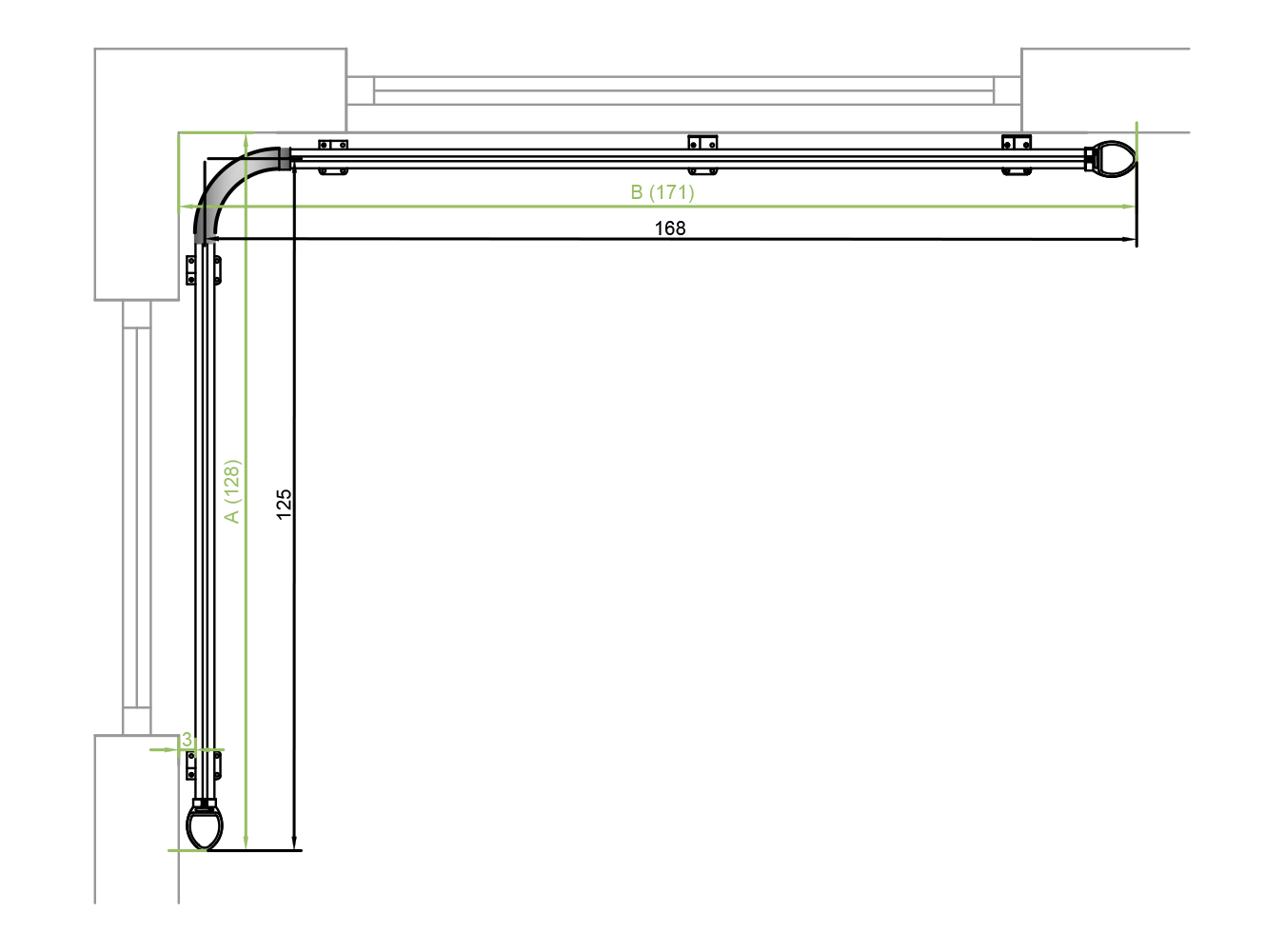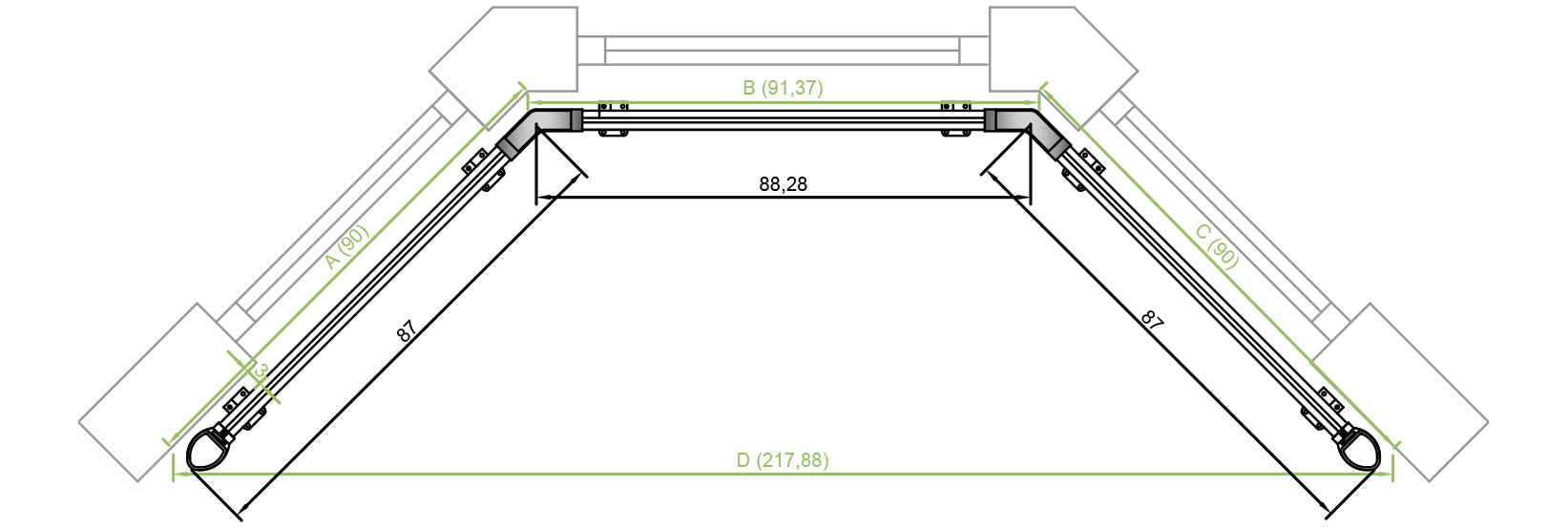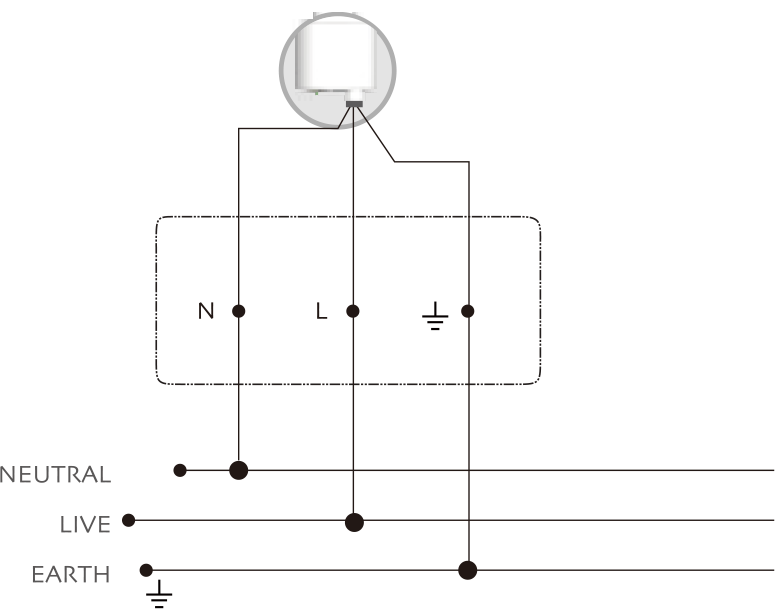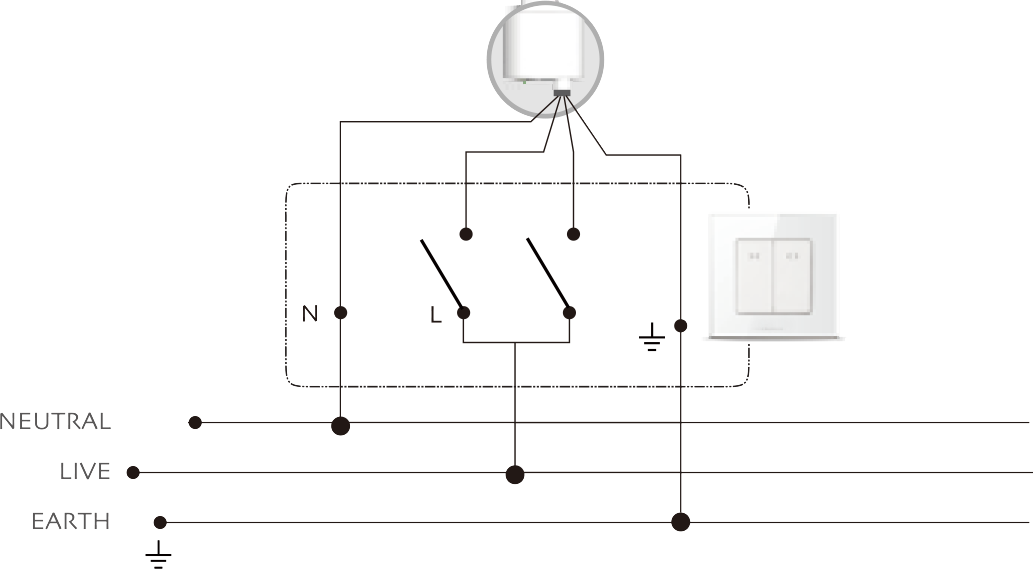Our guide to measuring and fitting electric curtain motors. Here at M-Systems we understand the challenges with integrating technology into every day life. However, as the world moves into the realms of home automation and IoT (Internet of Things) these changes will soon become the norm. So, in order to help make this as painless as possible we have compiled some bits of information below that are designed to make life as easy as possible;
Length – The first question to ask? How long does your curtain track need to be? and although that may seem a simple question the thing to understand is it will depend on the style you want, but as a standard its recommended that you measure for the width of the window plus and additional 20/30cm, this will ensure your curtains will comfortably cover your window plus any bleed of light that may creep around the sides.
Using the below diagram as an example, the window opening itself is 145cm, so the curtain track is measured at 185cm with the curtain box giving a 5cm gap at each end.
 When it comes to the mounting brackets, we will supply a number of brackets with each track based on the following calculation, (2+n) meaning that with the first meter of track we supply two brackets, plus an additional bracket for every additional meter. Our tracks also come with two mounting options, Wall and Ceiling, these can be selected customising your purchase on the product page.
When it comes to the mounting brackets, we will supply a number of brackets with each track based on the following calculation, (2+n) meaning that with the first meter of track we supply two brackets, plus an additional bracket for every additional meter. Our tracks also come with two mounting options, Wall and Ceiling, these can be selected customising your purchase on the product page.
Multiple Tracks – Good news for those who wish to automate both a netting along with an over curtain, with the use of our remotes its possible to have two layers of curtains within the same windows and control them both with the single remote, to ensure that you have the available space needed to hang both tracks please review the below guide. note we also supply double wall brackets for such a situation, if you require this simply request a double wall bracket when making your purchase.

Angles – As not all windows are the same we are able to supply angles at both 90 and 135 degrees in order to fit the most common bay and recessed windows. However, measuring for these can be a complex task, so in order to ensure that you have the correct measurements you can follow the below guide.
In order to measure the correct length for a Bay or Corner window, using the below diagrams as an example obtain the lengths of A and B for a Corner Window or A, B and C for a Bay Window (for Bay Windows also gather measurement D so that we can validate that the measurements and angles are correct) . After, add the lengths (A+B or A+B+C) together to get the total length required and purchase from the sizes available including the number of bends needed. Please note that tracks for Corner and Bay windows will be reduced in size by 3cm to allow for the wall/ceiling brackets to be fitted.
Example 1 – A= 128cm B= 171cm , Total= 299cm, in this example a track of 300cm would be required track and one 90 degree bend, during assembly the track would be cut down to the measured lengths.

Example 2 – A= 89cm B= 91cm C= 89cm, Total= 269m, in this example a track of 300cm would be required track and two 135 degree bend, during assembly the track would be cut down to the measured lengths.

Our Tracks are made from the best quality 2.4mm aluminium, however the total supported load of our tracks depends on the length of the track itself plus the mode of operation, such as side or center opening, plus the number of bends in the track. The below table is a guideline of the supported weights for each track configuration.
| Track type | 2m Track | 3m Track | 4m Track | 5m Track | 6m Track | 8m Track | 12m Track |
|---|---|---|---|---|---|---|---|
 | 52.5kg | 51.25kg | 50kg | 48.75kg | 47.5kg | 45kg | 40kg |
 | 62.5kg | 61.25kg | 60kg | 58.75kg | 57.5kg | 55kg | 50kg |
 | 42.5kg | 41.25kg | 40kg | 38.75kg | 37.5kg | 35kg | 30kg |
 | 47.5kg | 46.25kg | 45kg | 43.75kg | 42.5kg | 40kg | 35kg |
 | 32.5kg | 31.25kg | 30kg | 28.75kg | 27.5kg | 25kg | 20kg |
 | 37.5kg | 36.25kg | 35kg | 33.75kg | 32.5kg | 30kg | 25kg |
M-Systems advises that only competent and certified professionals should work with electrics. However, our curtain motors consist of a simple 240v 3 wire and 4 wire system;
3 Wire Systems are used within our RF motors and consist of a single power, neutral and earth. Controlling the operation of the motor is done via the remote or an RF bridge/transmitter. For more detail see the below schematic. 4 Wire Systems are used within out standard motors, these utilities two power connections (one for Open and the other for Close operations), neutral and earth, these motors should be wired into a high load switch. For more detail see the below schematic.
4 Wire Systems are used within out standard motors, these utilities two power connections (one for Open and the other for Close operations), neutral and earth, these motors should be wired into a high load switch. For more detail see the below schematic.

Home Automation allows you to control many aspects of your home or office environment, from your heating/cooling, lights, Audio Visual systems, security, the power for home appliances and now with the onset of IoT (internet of things) this control is expanding tremendously into actually controlling the smaller aspects and functions of these appliances!
Now this is where things get interesting, ever wanted to automatically have your curtains open in the morning and close in the evening based on a schedule or even sunset and sunrise? Or how about increasing your properties security by having your curtains open and close at different times each day when you are away? Well, there are multiple possibilities of integrating your curtain motors into home automation, from the simple to the not so simple. Below we have gathered some information to help simplify this as much as possible.
Remote Controlled Motors
The Remote Controlled Motors in our shop come with RF remotes, this will allow you to control your curtains with ease and simplicity. The RF controls work on a 433.92 frequency and can be replaced or supplemented by the various options below;
Timer Remotes
Also available in our shop are Single Channel with Timer remotes, these remotes allow you to set a simple time for Open and Close each day of the week. Once set, the remote will send the signal to the curtain motor initiating the open or close operation, this is a cost effective solution for a single curtain motor that allows automation whilst still having a manual control over the curtains.
RF Hub
There are various RF transmitters on the market that will allow you to control your remote controlled curtain motors, essentially these ‘hubs’ operate with the same RF frequency as our remotes and are usually a static device with no buttons, RF hubs bring multiple advantages such as being able to control the curtains from a mobile phone application, operation scheduling and the ability to control multiple devices within the same unit, additionally they are also able to use the same interface to control various IR devices. Some small disadvantages come into play in the fact that they are not a quick ‘to hand’ operation as you would get with the supplied remote (even opening applications on your phone takes time) also some frequencies may not travel to through multiple walls to other rooms depending on the build of your home.
Home Automation Controllers
Similar to ZWave (which we will cover shortly) there are various controllers on the market that utilize the RF frequency these controllers are similar to RF hubs except they are more developed and come with a lot more features. This is truly stepping into the world of Home Automation, even some of the Home Automation Controllers that do not have built-in compatibility for RF are able to use RF Bridges, for Example Vera Plus (Which predominantly uses ZWave) can be integrated with the RFXtrx433 Kit, this allows you to control both ZWave and RF devices which will broaden your home automation control as long as you can learn and re-emit RF commands.
Standard Motors
Initially, the standard motors are controlled by using a wall switches, however the common usage for these motors is to be integrated into a Home Automation system, this can be done with the use of a Z-Wave Roller Shutter or Curtain Module, although we do not personally supply these modules (Yet!) they can be purchased from various online retailers, some examples of these relays are;
Wall Switch with Timer
Another product that we are also looking to develop into our offering is a wall mounted switch which offers a timer functionality, this work in the same fashion as the remote timer but is contained within a wall switch with a display. This switch will also be able to control two layers of curtains (mesh and fabric) – coming soon.
Z-Wave Shutter/Curtain Modules
Z-Wave Modules are small devices which can be wired into your electrics and communicate with a ZWave gateway. The gateways often have a mobile application that is used to interface with the devices, set them up to timers or trigger the actions based on events plus control the various other home automation devices that you may have in your home or office. Examples of ZWave modules are the ‘Fibaro FGR-222 Roller Shutter’ 2 or ‘Qubino Flush Shutter DC’.
Optional ZWave Remote
Although Z-Wave gateways provide scheduling and triggers, if you want to control your curtains quickly and dont want to reach for the phone or tablet, there are various Z-Wave remotes on the market that will operate in the same way as out RF Remotes, these can be programmed and used to operate the ZWave module.
ZWave or RF?
So now I hear you ask ‘What Does ZWave Control give me that RF Control Doesn’t?’. Well that was quite a bit of information to take in, now its about deciding which technology you would like to use, are there any benefits to ZWave over RF? Well yes, some! ZWave allows for status reporting from the ZWave Modules, so not only can you trigger a module to perform an action, but you can also get it to report back the power consumption being drawn by the device, also get the module to report the current status and tell you if your curtains are open or closed, this can then be used in scenes and triggers, for instance if the curtains are closed and your motion sensors in your bedroom detect that you have got up before your usual alarm then it can trigger the curtains to open at that point. Sounds amazing right? It is… but like everything there are disadvantages, for instance ZWave is a little more expensive than using RF (LightWaveRF) and ZWave Modules require a ZWave Gateway, where as an RF Hub can work independently with your phone, so ZWave certainly has a bigger investment but can of course achieve greater results.
